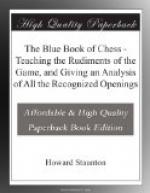1. e4 e5 2. Nf3 Nc6 3. Bc4 Bc5 4. c3 f5 5. d3 Nf6 6. exf5 d5 7. Bb5 Qd6 8. O-O O-O 9. b4 Bb6 10. h3 Bxf5 11. Bxc6 bxc6 12. d4 e4 13. Ne5 a5 14. Ba3 axb4 15. Bxb4 c5 16. dxc5 Bxc5 17. Bxc5 Qxc5 18. Qd4 Qd6 19. Ng4 Bxg4 20. hxg4 Nxg4 21. g3 Qh6 22. Rd1 Qh2+ 23. Kf1 Rxf2+ {and wins.} 0-1
{PGN 13}
[Event “?”] [Site “?”] [Date “????.??.??”] [Round “?”] [White “Staunton, Howard”] [Black “Horwitz”] [Result “1-0”] [ECO “C53”] [Annotator “The Blue Book of Chess, Game III., p. 80”] [PlyCount “143”]
1. e4 e5 2. Nf3 Nc6 3. Bc4 Bc5 4. c3 d6 5. d4 exd4 6. cxd4 Bb6 7. Nc3 Bg4 8. Be3 Nf6 9. a3 O-O 10. Be2 Re8 11. d5 Ne5 12. Nxe5 Bxe2 13. Qxe2 Rxe5 14. Bxb6 axb6 15. O-O Nxe4 16. Nxe4 f5 17. f3 fxe4 18. fxe4 Qe7 19. Rae1 Re8 20. Rf4 h6 {Black would have gained no advantage by Rxd5 at this juncture, or by advancing g5 to attack the Rook. The move in the text was not made without due deliberation, and we believe it the best on the board.} 21. Qf3 {White designedly gives up the Queen’s Pawn, to get a counter attack with his combined forces.} Rxd5 22. Rf1 {Qb3 would have been worse than useless.} Re5 23. Rf7 Qe6 ({Had he gone Qd8, to protect his threatened Pawn, White would have won the g7 Pawn. e.g.} 23... Qd8 24. Rxg7+ Kxg7 25. Qf7+ Kh8 26. Rf6 Rh5 27. Qxh5 Qxf6 28. Qxe8+) 24. Rxc7 Rxe4 25. Rxb7 d5 26. h3 {A most important move. Black dare not now advance d4 on account of Qf7+, which would enable White to double his Rooks on the adversary’s g7, and thus win easily.} Re1 27. Rxe1 Qxe1+ 28. Qf1 (28. Kh2 {would have been very bad play, because} Qe5+ 29. Qg3 Qxg3+ 30. Kxg3 Re3+ 31. Kh2 Rb3) 28... Qe3+ 29. Qf2 Qc1+ 30. Kh2 Rf8 31. Qd4 Rf6 {He could not save all the Pawns attacked.} 32. Qxd5+ Kh7 33. Qe5 Rg6 {Threatening Rxg2, and then Qc6+.} 34. Re7 Qd2 35. Qe4 Qd6+ 36. Re5 Kg8 37. Qd5+ Qxd5 38. Rxd5 Kf7 39. Rb5 Ke7 40. g4 Kd7 41. Kg3 Kc6 42. Re5 Rd6 43. Re3 Kc5 44. h4 g6 45. Kf4 Kd4 46. Re4+ Kd5 47. Re8 Rf6+ 48. Ke3 Kc4 49. Re4+ Kd5 50. Rf4 Rc6 51. Rb4 Re6+ 52. Kd3 Rf6 53. Rb5+ {Ke3 would have been better.} Kc6 54. Re5 Kd6 55. Rb5 Kc6 56. Rb4 Rf3+ 57. Ke2 Rh3 58. Rf4 Rxh4 59. Rf6+ Kb5 60. Rxg6 Rh2+ 61. Kf3 Rxb2 62. Rxh6 Rb3+ 63. Kf4 Rxa3 64. g5 Ra1 65. Rh4 Kc5 66. g6 Ra7 67. Kf5 b5 68. Rg4 b4 {This was ill-judged. He should have played Rg7, or Ra8.} 69. g7 Rxg7 70. Rxg7 b3 71. Ke4 Kb4 72. Kd3 1-0
{PGN 14}
[Event “?”] [Site “?”] [Date “????.??.??”] [Round “?”] [White “Horwitz”] [Black “Staunton, Howard”] [Result “0-1”] [ECO “C54”] [Annotator “The Blue Book of Chess, Game IV., p. 83.”] [PlyCount “64”]




